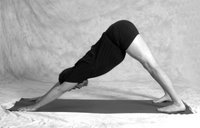It seems like practically every adult in the West has a cervical spine that can be described as some variation of a tense upper, hypermobile middle, and a rigid lower neck. Our excessively visual world pulls our heads forward as we focus outward. In our culture, we sit entirely too much in chairs peering into monitors, over steering wheels, and across tables. This forward head posture along with dull, flexed thoracic and lumbar spines are the cause of many musculo-skeletal symptoms.
The muscles that extend the cervical spine were not designed to hold our heads up for a long duration. A skillful lengthening spine is suppose to support the head. The excessive muscle work ends up in a mass of tension right under the occiput [most prominent bump on the back of our heads]. Many muscles that start from the pelvis, ribs, and shoulder blades attach under the occipital ridge. These muscle insertions are very tense all of the time, if not when holding our head up, then when trying to relax on a pillow, but still contracting as high resting tone. The upper 3 or so vertebraes do not move much from their capital extension position because of the muscular tension. Body workers are always digging their fingers in this muscle tension under the occipital ridge.
The mid cervical veretebraes are notorious for a diagnosis such as cervical disk herniation or cervical spondylosis. The relatively excessive movement in C4, C5, C6 simply wear away the disks, joint linings, and cause abnormal mechanical stress to form osteophytes [spurs] . Cervical spondylosis is this arthrosis of the spine with spurs and joint degeneration. The cervical disk walls can handle so much mechanical stress before the lateral walls begin to weaken and herniation [bulging] begins.
It seems everyone in the West has a cervical veretbra #7 that pokes out in the back of their neck. If we run our finger down the back of our neck, C7 is very noticable as it is the first veretebra to stick out from the top down.
The thoracic spine continues this moving backwards creating a rounded upper back [kyphosis], starting from C7. This lower cervical and thoracic spine is usually dull, tight, and stiff in flexion. The epitome is our grandparent with osteoporosis and the infamous Dowager hump. Sometimes they even have hemiveretebra fractures, where they literally lose height. Dullness of our spine is not as extreme as it is for our grandparents. But most of us have dull spines in part due to poor centers, and a lack of grounding in our legs.
I believe our entire body needs to support our heads. The skills of grounds our legs, centering our pelvis, and lengthening our spines are necessary to support the position and movement of our heads. Hatha Yoga is one great way to develop these skills with standing poses.
Chest openers are an absolute necessity to increase the flexibility of our thoracic spines towards back bending. Bridge pose, up dog, and wheel pose have important spinal backbending movements that our dull flexed spines need.
We use a hard plastic wedge designed by Joe Mannella DC [http://neckorthotic.com]. Briefly, we first place the wedge direct under the occipital ridge to release the deep set muscular tension. We briefly roll through the hypermobile mid cervical spine while supporting the head, so not to hyperextend into compression. Then we turn the wedge around to press just before, directly on, and just after C7.
Associated with forward head are very tense top shoulder blade muscles [levator scapula] and side neck muscles [scaleni]. We also perform a headless headstand in-between 2 folding chairs to release this hypertonus.
The litmus test is the standing poses. Can we continue to ground, center, and lift as we move through the different ranges of standing poses, whiles lengthening our cervical spines to support the movement of our head and arms?
